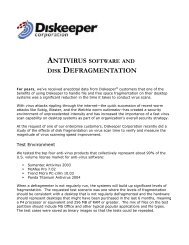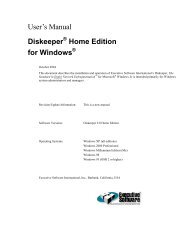Diskeeper 10 User's Manual
Diskeeper 10 User's Manual
Diskeeper 10 User's Manual
Create successful ePaper yourself
Turn your PDF publications into a flip-book with our unique Google optimized e-Paper software.
<strong>Diskeeper</strong> Operation 41<br />
• Don’t run boot-time defragmentation—Use this option to clear a previously-scheduled boot-time<br />
operation. This option is useful for cases where you’ve scheduled a boot-time defragmentation, then<br />
decided to postpone the operation.<br />
Put all folders together on the volume<br />
Check this box to defragment and consolidate the directories of the selected volumes, next time your computer<br />
starts up.<br />
Run the system “CHKDSK” utility before defragmentation<br />
Use this control to specify whether the Windows CHKDSK disk error checking utility is run (using the /F<br />
qualifier) before the boot-time operation. Running CHKDSK adds time to the Boot-Time defragmentation<br />
operation, but it can correct disk errors that otherwise would hamper effective directory consolidation.<br />
Note: Enabling the CHKDSK option will cause CHKDSK to run on each selected volume before the Boot-<br />
Time defragmentation process. The time increase can be considerable and <strong>Diskeeper</strong> Corporation therefore<br />
recommends performing boot-time defragmentation on one volume at a time.<br />
Also Note: After enabling the CHKDSK option, you will not be able to run either Set It and Forget It or manual<br />
defragmentation on the disk until you reboot. For this reason, <strong>Diskeeper</strong> Corporation recommends waiting to<br />
enable this option until just before you are ready to reboot your computer.<br />
Defragment the paging file<br />
Check this box to defragment the paging file of the selected volume the next time your computer starts up.<br />
Defragment the Master File Table (MFT)<br />
Check this box to defragment the MFT of the selected volume the next time your computer starts up.<br />
Pause to view screen after defragmentation<br />
When enabled, this option causes the Boot-Time operation to pause after completion. It remains in this paused<br />
state until you manually restart your computer (by either pressing the Reset button or turning off the power<br />
switch). If this option is not enabled, the Boot-Time defragmentation operation pauses a short 15 seconds (to<br />
allow you to read any messages on the monitor screen), then automatically restarts your computer.<br />
Produce a summary log file<br />
Use this option to cause a text file to be written that summarizes the Boot-Time defragmentation operation.<br />
When this option is enabled, a default volume letter, directory, and file name are shown in the dialog box<br />
similar to this:<br />
By default, the summary file is written to your floppy drive (A:). This dialog box can be edited to specify<br />
another volume, directory path, and filename. However, the summary file cannot be written to the volume upon<br />
which you are running Boot-Time defragmentation. Also note that the filename should not contain any spaces.<br />
Note: Some computers read the floppy drive at boot-time. We therefore recommend not writing the summary<br />
file to the A: drive, unless no other volumes are available.<br />
Perform Boot-Time Defragmentation Job even if this drive is being used by<br />
remote users<br />
When this option is set, the computer will force a reboot at the scheduled date and time, if the At scheduled<br />
time option has been selected, regardless of whether or not anyone is logged on to the machine. Users who are<br />
logged on will be notified at regular intervals, starting one hour before the scheduled reboot, to give them an<br />
opportunity to log off.






